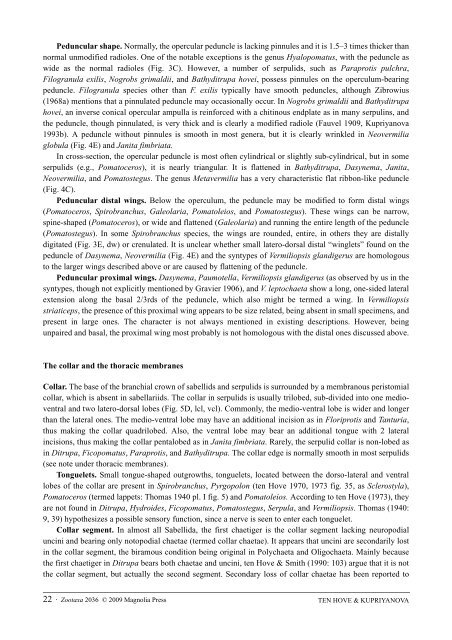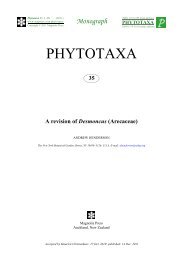Zootaxa, Taxonomy of Serpulidae (Annelida ... - Magnolia Press
Zootaxa, Taxonomy of Serpulidae (Annelida ... - Magnolia Press
Zootaxa, Taxonomy of Serpulidae (Annelida ... - Magnolia Press
Create successful ePaper yourself
Turn your PDF publications into a flip-book with our unique Google optimized e-Paper software.
Peduncular shape. Normally, the opercular peduncle is lacking pinnules and it is 1.5–3 times thicker than<br />
normal unmodified radioles. One <strong>of</strong> the notable exceptions is the genus Hyalopomatus, with the peduncle as<br />
wide as the normal radioles (Fig. 3C). However, a number <strong>of</strong> serpulids, such as Paraprotis pulchra,<br />
Filogranula exilis, Nogrobs grimaldii, and Bathyditrupa hovei, possess pinnules on the operculum-bearing<br />
peduncle. Filogranula species other than F. exilis typically have smooth peduncles, although Zibrowius<br />
(1968a) mentions that a pinnulated peduncle may occasionally occur. In Nogrobs grimaldii and Bathyditrupa<br />
hovei, an inverse conical opercular ampulla is reinforced with a chitinous endplate as in many serpulins, and<br />
the peduncle, though pinnulated, is very thick and is clearly a modified radiole (Fauvel 1909, Kupriyanova<br />
1993b). A peduncle without pinnules is smooth in most genera, but it is clearly wrinkled in Neovermilia<br />
globula (Fig. 4E) and Janita fimbriata.<br />
In cross-section, the opercular peduncle is most <strong>of</strong>ten cylindrical or slightly sub-cylindrical, but in some<br />
serpulids (e.g., Pomatoceros), it is nearly triangular. It is flattened in Bathyditrupa, Dasynema, Janita,<br />
Neovermilia, and Pomatostegus. The genus Metavermilia has a very characteristic flat ribbon-like peduncle<br />
(Fig. 4C).<br />
Peduncular distal wings. Below the operculum, the peduncle may be modified to form distal wings<br />
(Pomatoceros, Spirobranchus, Galeolaria, Pomatoleios, and Pomatostegus). These wings can be narrow,<br />
spine-shaped (Pomatoceros), or wide and flattened (Galeolaria) and running the entire length <strong>of</strong> the peduncle<br />
(Pomatostegus). In some Spirobranchus species, the wings are rounded, entire, in others they are distally<br />
digitated (Fig. 3E, dw) or crenulated. It is unclear whether small latero-dorsal distal “winglets” found on the<br />
peduncle <strong>of</strong> Dasynema, Neovermilia (Fig. 4E) and the syntypes <strong>of</strong> Vermiliopsis glandigerus are homologous<br />
to the larger wings described above or are caused by flattening <strong>of</strong> the peduncle.<br />
Peduncular proximal wings. Dasynema, Paumotella, Vermiliopsis glandigerus (as observed by us in the<br />
syntypes, though not explicitly mentioned by Gravier 1906), and V. leptochaeta show a long, one-sided lateral<br />
extension along the basal 2/3rds <strong>of</strong> the peduncle, which also might be termed a wing. In Vermiliopsis<br />
striaticeps, the presence <strong>of</strong> this proximal wing appears to be size related, being absent in small specimens, and<br />
present in large ones. The character is not always mentioned in existing descriptions. However, being<br />
unpaired and basal, the proximal wing most probably is not homologous with the distal ones discussed above.<br />
The collar and the thoracic membranes<br />
Collar. The base <strong>of</strong> the branchial crown <strong>of</strong> sabellids and serpulids is surrounded by a membranous peristomial<br />
collar, which is absent in sabellariids. The collar in serpulids is usually trilobed, sub-divided into one medioventral<br />
and two latero-dorsal lobes (Fig. 5D, lcl, vcl). Commonly, the medio-ventral lobe is wider and longer<br />
than the lateral ones. The medio-ventral lobe may have an additional incision as in Floriprotis and Tanturia,<br />
thus making the collar quadrilobed. Also, the ventral lobe may bear an additional tongue with 2 lateral<br />
incisions, thus making the collar pentalobed as in Janita fimbriata. Rarely, the serpulid collar is non-lobed as<br />
in Ditrupa, Ficopomatus, Paraprotis, and Bathyditrupa. The collar edge is normally smooth in most serpulids<br />
(see note under thoracic membranes).<br />
Tonguelets. Small tongue-shaped outgrowths, tonguelets, located between the dorso-lateral and ventral<br />
lobes <strong>of</strong> the collar are present in Spirobranchus, Pyrgopolon (ten Hove 1970, 1973 fig. 35, as Sclerostyla),<br />
Pomatoceros (termed lappets: Thomas 1940 pl. I fig. 5) and Pomatoleios. According to ten Hove (1973), they<br />
are not found in Ditrupa, Hydroides, Ficopomatus, Pomatostegus, Serpula, and Vermiliopsis. Thomas (1940:<br />
9, 39) hypothesizes a possible sensory function, since a nerve is seen to enter each tonguelet.<br />
Collar segment. In almost all Sabellida, the first chaetiger is the collar segment lacking neuropodial<br />
uncini and bearing only notopodial chaetae (termed collar chaetae). It appears that uncini are secondarily lost<br />
in the collar segment, the biramous condition being original in Polychaeta and Oligochaeta. Mainly because<br />
the first chaetiger in Ditrupa bears both chaetae and uncini, ten Hove & Smith (1990: 103) argue that it is not<br />
the collar segment, but actually the second segment. Secondary loss <strong>of</strong> collar chaetae has been reported to<br />
22 · <strong>Zootaxa</strong> 2036 © 2009 <strong>Magnolia</strong> <strong>Press</strong><br />
TEN HOVE & KUPRIYANOVA
















